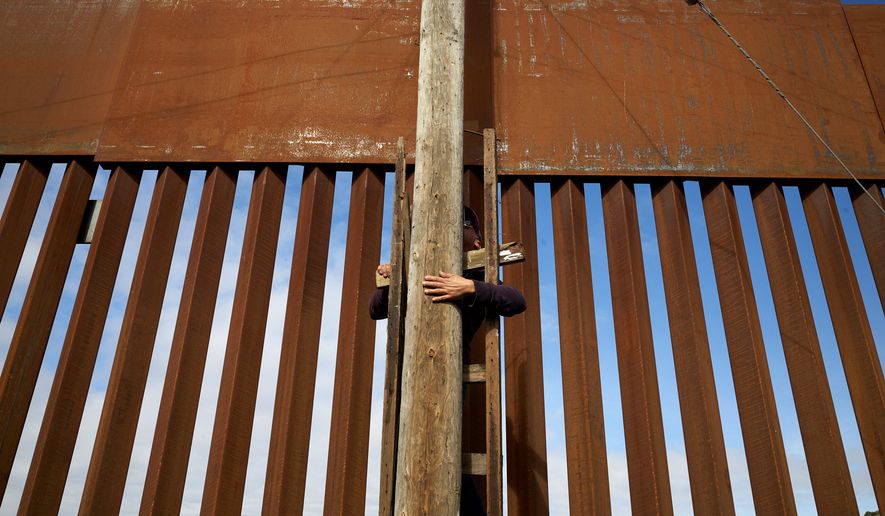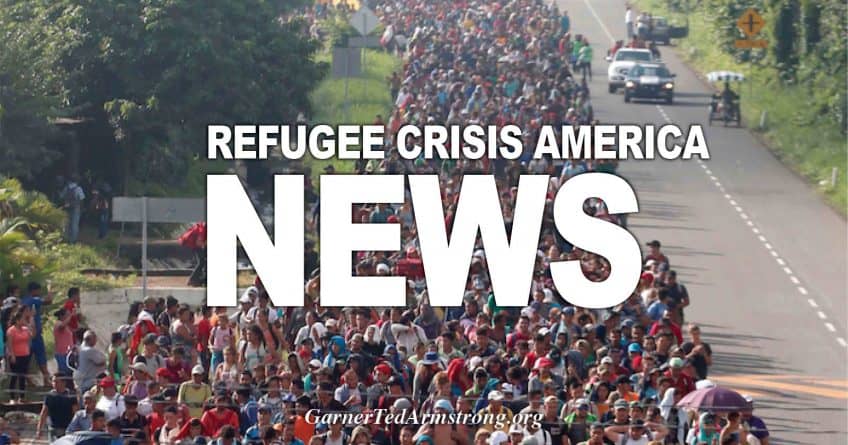New surge comprised of migrant families and children, which are a much tougher population to combat.

Photo by: Gregory Bull In this Jan. 16, 2019, image, a man uses a ladder to climb an electrical pole in a border neighborhood in Tijuana, Mexico, alongside a newly-replaced section of the border wall. The U.S. faces a delicate dance as it charts a course to extend or replace border barriers near homes and structures. (AP Photo/Gregory Bull)
Illegal immigration across the southwest border is on pace for the worst year since 2007 — or the last time the country began a massive wall-building spree — according to new Homeland Security numbers.
Four months into the fiscal year the Border Patrol nabbed nearly 201,500 people, compared to about 109,500 at the same point in the previous year. If that 84 percent surge holds, it works out to 733,000 immigrants crossing illegally for fiscal year 2019, which would be by far the highest numbers in more than a decade.
And the new surge is comprised of migrant families and children, which are a much tougher population to combat, thanks to U.S. policies imposed by Congress and the courts that make it tougher to deport them.
“Family units and unaccompanied children from Central America are crossing the border illegally in greater numbers and in larger groups than ever before, straining our law enforcement resources,” said Brian Hastings, U.S. Border Patrol Chief of Operations. “These trends are very concerning and demonstrate the reality of the ongoing humanitarian and border security crisis.”
The number of families nabbed through the first four months of fiscal year 2019 is up 290 percent compared to the same point in 2018, authorities said, with mini-caravans of hundreds of people now a regular occurrence.
Late last week in Arizona, agents spotted a group of 325 people who’d jumped the border in remote desert country west of Lukeville.
That’s an area where there’s no border wall, but rather low-slung metal poles and crossbars that are meant to stop vehicles. They are easy for someone on foot to step over or crawl under.
Of the 325, 150 were children — and 32 of them unaccompanied, meaning they were traveling without their parents.
It took agents several hours to do an initial health screen, then pack the migrants into vans and take them to take them to a staging area where they could be picked up by buses and taken to a Border Patrol facility for processing.
During the medical screen, two children were deemed to need immediate medical attention: One 5-year-old had chicken pox, and a 12-year-old had a skin infection.
Members of the mini-caravan said they’d been dropped off by buses and trucks that used Mexican Federal Highway 2, a high-speed road that runs a parallel track just 50 yards south of the border, to deliver them. They massed, then crossed as a group at 8 a.m. on Thursday, and sat to wait for agents to find them.
A day later and several hundred miles to the east, agents arrested 290 people in a mini-caravan near Antelope Wells, New Mexico.
A border official told reporters large groups are often used as distractions by the cartels, who control both the human and drug trafficking traffic across the border, planning where each type of cargo will cross.
The cartels will send a large group over, knowing it will absorb an entire area’s contingent of agents, — then send a shipment of drugs across the border in a nearby location, confident that the agents are occupied feeding or performing medical checks on the migrants and won’t be able to respond.
“They’re using these large groups to facilitate the crossing of narcotics because they know they’ve tied up a large percentage of our manpower,” the Customs and Border Protection official said, briefing reporters Friday on the latest numbers and tactics.
On any day, about 150 Border Patrol agents are pulled out of the field and have to do “hospital watch,” staying with hundreds of migrants who were so sick when they arrived that they needed immediate medical attention, officials said.
Chicken pox, measles, mumps and other infectious diseases are common.
Through the first four months of fiscal year 19, Homeland Security had seen 60 large groups — defined as at least 100 migrants. In 2018, the number was just 13. And in 2017 it was just one.
Thursday’s group of 325 came in February, too late for the January statistics which officials released Friday.
Those stats showed the Border Patrol caught 47,893 immigrants trying to jump the border, and CBP officers encountered another 10,314 immigrants who showed up at official border crossings and entered without permission.
Of those nabbed at the border, 24,116 came as families and 5,124 were unaccompanied children.
The total number and the number of family members are both down a bit from December — but officials said they saw a surge in the final weeks of January, suggesting that the trend line is picking up again.
Arrests are considered a good approximation of the overall flow of people. More arrests likely mean more people are getting through.
At the turn of the century, the government was catching more than 1.5 million immigrants a year illegally crossing the border.
That remained at about 1 million a year through 2006, then dropped to about 850,000 in 2007, as the Bush administration deployed troops and began a massive round of fence-building. As those moves took hold, apprehensions dropped precipitously, to about 700,000 in 2008, 550,000 in 2009, and lower than 500,000 every year this decade.
The 733,000 the government is on track for this year would easily top that decade average.
The porous nature of American policy means those who are arrested are more likely to get a foothold in the U.S., despite their unlawful status.
Of the families and unaccompanied children nabbed in 2017, more than 98 percent of them were still in the U.S. as of late last year. Court rulings make it almost impossible to detain them, and once they’re released into communities they are difficult to roust, Homeland Security officials say.
Source: https://www.washingtontimes.com/news/2019/feb/10/illegal-immigration-mexico-border-pace-worst-2007/
[Disclaimer]









